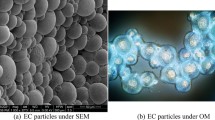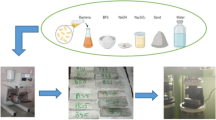Abstract
The nanostructure of cementitious materials has important effects on concrete properties. The effects of rice husk ash (RHA) on cement hydration product phases and interfacial transition zone (ITZ) in mortar were investigated from the nano-scale structure perspective. The experimental results indicate that, with the increase of RHA dosages of samples, the volume fraction of high-density calcium-silicate-hydrate (HD C-S-H) in porosity and hydration product phases increases. The volume fractions of HD C-S-H in C-S-H of samples show an increasing trend with the increase of RHA dosages. RHA decreases the thickness of ITZ and increases the matrix elastic moduli of samples, however, the RHA dosoges hardly affect the thickness and elastic moduli.
Similar content being viewed by others
References
Zahedi M, Ramezanianpour AA, Ramezanianpour AM. Evaluation of the Mechanical Properties and Durability of Cement Mortars Containing Nanosilica and Rice Husk Ash under Chloride Ion Penetration[J]. Constr. Build. Mater., 2015, 78: 354–361
Jamil M, Kaish ABMA, Raman SN, et al. Pozzolanic Contribution of Rice Husk Ash in Cementitious System[J]. Constr. Build. Mater., 2013, 47(5): 588–593
Prasittisopin L, Trejo D. Hydration and Phase Formation of Blended Cementitious Systems Incorporating Chemically Transformed Rice Husk Ash [J]. Cem. Concr. Compos., 2015, 31: 100–106
Rêgo JHS, Nepomuceno AA, Figueiredo EP, et al. Microstructure of Cement Pastes with Residual Rice Husk Ash of Low Amorphous Silica Content[J]. Constr. Build. Mater., 2015, 80: 56–68
Tadjarodi A, Haghverdi M, Mohammadi V. Preparation and Characterization of Nano-porous Silica Aerogel from Rice Husk Ash by Drying at Atmospheric Pressure[J]. Mater. Res. Bull., 2012, 47(9): 2584–2589
Antiohos SK, Papadakis VG, Tsimas S. Rice Husk Ash (RHA) Effectiveness in Cement and Concrete as a Function of Reactive Silica and Fineness[J]. Cem. Concr. Res., 2014, s61–62:20–27
Chopra D, Siddique R, Kunal. Strength, Permeability and Microstructure of Self-compacting Concrete Containing Rice Husk Ash[J]. Biosyst. Eng., 2015, 130: 72–80
Tuan NV, Ye G, Breugel KV, et al. Hydration and Microstructure of Ultra High Performance Concrete Incorporating Rice Husk Ash[J]. Cem. Concr. Res., 2011, 41(11):1104–1111
Ganesan K, Rajagopal K, Thangavel K. Rice Husk Ash Blended Cement: Assessment of Optimal Level of Replacement for Strength and Permeability Properties of Concrete[J]. Constr. Build. Mater., 2008, 22(8): 1675–1683
Gastaldini ALG, Silva MPD, Zamberlan FB, et al. Total Shrinkage, Chloride Penetration, and Compressive Strength of Concretes that Contain Clear-colored Rice Husk Ash[J]. Constr. Build. Mater., 2014, 54(3): 369–377
Vandamme M, Ulm FJ, Fonollosa P. Nanogranular Packing of C-S-H at Substochiometric Conditions[J]. Cem. Concr. Res., 2010, 40(1): 14–26
Allen AJ, Thomas JJ, Jennings HM. Composition and Density of Nanoscale Calcium-Silicate-Hydrate in Cement[J]. Nat. Mater., 2007, 6(4): 311–316
Chen JJ, Sorelli L, Vandamme M, et al. A Coupled Nanoindentation/ SEM-EDS Study on Low Water/Cement Ratio Portland Cement Paste: Evidence for C-S-H/Ca(OH)2 Nanocomposites[J]. J. Am. Ceram. Soc., 2010, 93(5):1484–1493
He ZH, Qian CX, Yi Z, et al. Nanoindentation Characteristics of Cement with Different Mineral Admixtures[J]. Sci. China. Technol. Sci., 2013, 56(5): 1119–1123
He ZH, Qian CX, Zhao F. Experimental Investigation of Creep of Cement Paste with Mineral Admixtures via Nanoindentation[J]. Nanosci. Nanotech. Let., 2014, 6(1): 51–56
He ZH, Qian CX. Nanoindentation Characteristics of Cement with Metakaolin under Different Curing Systems[J]. Nanosci. Nanotech. Let., 2014, 6(8): 721–725
Constantinides G, Ulm FJ. The Nanogranular Nature of C-S-H[J]. J. Mech. Phys. Solids., 2007, 55(1): 64–90
Lothenbach B, Scrivener K, Hooton RD. Supplementary Cementitious Materials[J]. Cem. Concr. Res., 2011, 41(3): 217–229
Li W, Xiao J, Sun Z, et al. Interfacial Transition Zones in Recycled Aggregate Concrete with Different Mixing Approaches[J]. Constr. Build. Mater., 2012, 35: 1045–1055
Author information
Authors and Affiliations
Corresponding author
Additional information
Funded by the National Natural Science Foundation of China (Nos.51602198, 41427802 and 41302257), the Zhejiang Provincial Natural Science Foundation of China (No. LQ13D020001) and the Shaoxing University Scientific Research Project (No. 20145030)
Rights and permissions
About this article
Cite this article
He, Z., Qian, C., Du, S. et al. Nanoindentation characteristics of cement paste and interfacial transition zone in mortar with rice husk ash. J. Wuhan Univ. Technol.-Mat. Sci. Edit. 32, 417–421 (2017). https://doi.org/10.1007/s11595-017-1613-y
Received:
Accepted:
Published:
Issue Date:
DOI: https://doi.org/10.1007/s11595-017-1613-y




